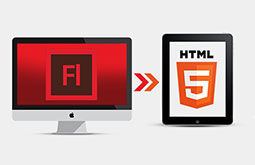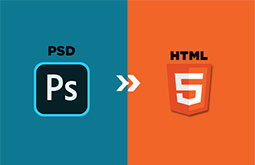7 Simple Steps to Convert Your PSD Files Into HTML5 Format
The creation of layered websites was one of the striking developments in the website designing domain in the last decade. Thanks to Photoshop, designers have found a new way to spice up the looks of websites; they can now create a far more visually appealing website.
However, they face considerable problems while incorporating these images in the actual website. The files, saved in a format called ‘PSD’, need to be transformed to HTML, or Hypertext Mark-up language. Hypertext mark-up language is an effective language, used to display various information and web pages. It also makes it easy for the users to find and view the content.
The trend of using Photoshop in web designs is widely implemented nowadays. An important part of this process is the conversion from PSD to HTML. Read on to know the different steps to carry out the conversion process.

The PSD to HTML conversion process
At the outset, you should note that the conversion process is quite complicated, so you should be an expert in dealing with codes. Alternatively, it is recommended to seek professional help for the purpose.
If you fail to incorporate the changes seamlessly, corrupted HTML is likely to trouble your website. This is the last thing that you would want to happen.
-
Step 1: Slicing the PSD files
You need to start the process by slicing the PSD file. This is done because the image file created in Photoshop is too heavy and static. You cannot upload it directly to the browser. Therefore, divide it into smaller chunks that can be easily managed.
For instance, you can create file divisions such as header, body, footer, or navigation. With the help of slicing, the coding process becomes easier and efficient. After slicing, save your file under “Save for the Web”.
-
Step 2: Creating the needed directories
Creating directories will help you organize and manage your data efficiently. Also, don’t just create only one. You can use two, three, or even more. For example, you can create a main folder with your website’s name. You can create another one to store all the pictures you will convert later. And, maybe a third one to save your CSS files or style sheets.
-
Step 3: Writing HTML and CSS code
In the next step, you need to code the sliced PSD segments into HTML or Hypertext mark-up language. It may take a bit of time, as it involves hard coding.
In order to create the HTML/CSS from PSD file, you should incorporate a good code editor, like Coda or Dreamweaver. However, these may turn out to be expensive for you. Alternatively, you can use any HTML5 editors. At first, it is wise to code the work and background, so that they appear in HTML. Then code the logo, navigation, footer, content and content area.
When you are generating your website template PSD to HTML5/CSS, make sure the navigation menu bar as simple as possible. Pay attention to the typography fonts of website when converting the design.
-
Step 4: Generate a website design template
Now, create a web design set by combining all the HTML and CSS elements together. When you are generating your website template, make sure that the navigation menu bar is as simple as possible. Also, pay attention to the typography fonts of the website when converting the design.
-
Step 5: Allow JavaScript
The next step is to use JavaScript to create a dynamic front-end. For this, you can use jQuery and related frameworks, such as vue.js and react.js. It will enable you to easily connect the HTML elements to javaScript data and functions.
You can also use AngularJS for the same. It will allow you to use MCV styles to dynamically set the data within the HTML elements.
-
Step 6: The conversion should be SEO semantic
One of the very important things to keep in mind when you convert PSD into responsive HTML is that you need to understand the basics of semantic coding in SEO. It’s important, as your website will be able to feature in search engines according to your niche. It will lead to increased traffic and thus conversion. You should incorporate ALT tags, descriptions of Meta Tags and heading tags wherever necessary.
-
Step 7: Testing the code and validating
The last step involves testing the code and validating the same. If you have misspelt any piece or any unclosed code of HTML remains in the process, it will show up in the testing process. It will thus ensure that the standard of your website will adhere to the level prescribed by the World Wide Web Consortium (W3C). As the process is time consuming, the best option is to use a validation tool.
Conclusion
When you think of designing a new website, the two most important elements include HTML and PSD files in Photoshop. Designing and developing a fully functional website may seem daunting at first.
Moreover, the PSD to HTML5 conversion seems too technical. However, with time, practice, and acquired technical skills, a novice web designer can reach a professional level.
So, if you are a beginner and want to start a blooming career in web design, start today. Bookmark this article and learn the steps for converting PSD files into HTML5 formats. Alternatively, if you require expert help, seek assistance from professional web design company to convert your PSD files into compatible website.




